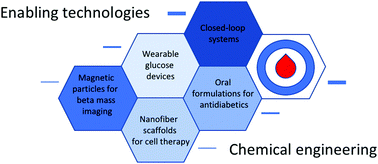The impact of chemical engineering and technological advances on managing diabetes: present and future concepts
Abstract
Monitoring blood glucose levels for diabetic patients is critical to achieve tight glycaemic control. As none of the current antidiabetic treatments restore lost functional β-cell mass in diabetic patients, insulin injections and the use of insulin pumps are most widely used in the management of glycaemia. The use of advanced and intelligent chemical engineering, together with the incorporation of micro- and nanotechnological-based processes have lately revolutionized diabetic management. The start of this concept goes back to 1974 with the description of an electrode that repeatedly measures the level of blood glucose and triggers insulin release from an infusion pump to enter the blood stream from a small reservoir upon need. Next to the insulin pumps, other drug delivery routes, including nasal, transdermal and buccal, are currently investigated. These processes necessitate competences from chemists, engineers-alike and innovative views of pharmacologists and diabetologists. Engineered micro and nanostructures hold a unique potential when it comes to drug delivery applications required for the treatment of diabetic patients. As the technical aspects of chemistry, biology and informatics on medicine are expanding fast, time has come to step back and to evaluate the impact of technology-driven chemistry on diabetics and how the bridges from research laboratories to market products are established. In this review, the large variety of therapeutic approaches proposed in the last five years for diabetic patients are discussed in an applied context. A survey of the state of the art of closed-loop insulin delivery strategies in response to blood glucose level fluctuation is provided together with insights into the emerging key technologies for diagnosis and drug development. Chemical engineering strategies centered on preserving and regenerating functional pancreatic β-cell mass are evoked in addition as they represent a permanent solution for diabetic patients.



 Please wait while we load your content...
Please wait while we load your content...